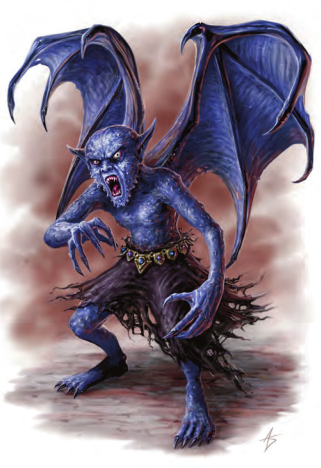Let's Read the 4e Monster Manual/Vault: Berbalang

Berbalangs are ghouls from filipino myth, and were first made into D&D monsters in an old issue of White Dwarf back in the OD&D days. Here, they’re only on the Monster Manual.
The Lore
Despite the impy look of the picture, Berbalangs are Medium! They’re Immortal Humanoids and Evil, but are not devils. The book doesn’t say much about their in-setting origin, but what little description is there implies berbalangs live in the world and not on the Astral Sea. They’re definitely sapient with Int 14, and speak Supernal.
They feed on the flesh and bones of dead humanoids, but that’s just a carrier for their real source of nourishment: the memories of the deceased. The creature relives those memories when it sleeps, and derives sustenance from them. It doesn’t matter whether the corpse is fresh or centuries old, the memories encoded in its physical form will still serve as food just fine.
Some berbalangs take up residence in remote villages, where they make a deal with the local leadership: instead of burying their dead, they offer them up to the monster, presumably in exchange for protection against other threats. If no one has died of natural causes recently, the berbalang instead demands a sacrifice.
Berbalangs are solitary, but will occasionally share their lairs with other monsters that like dwelling in tombs and crypts.
The Numbers
Berbalangs are Level 10 Solo Skirmishers with 408 HP. Their AC and Reflex are strong for their level, and their Will is slightly weak. They have a ground speed of 6 and a flight speed of 8.
The only reason I don’t consider them the most gimmicky monster I saw so far is because I just reviewed beholders. You see, the berbalang’s main ability is Summon Duplicate, an at-will minor action. While not bloodied, the creature can create up to four psychic duplicates of itself. Creating a duplicate costs the berbalang one quarter of its current hit points, which become that duplicate’s HP. So a healthy berbalang can create three duplicates with 104, 76 and 57 HP respectively, leaving itself with 171.
The duplicates have all the same statistics of the original, and the damage of their attacks is psychic. They act as fully independent combatants and can be targeted by PCs normally. A berbalang can use a standard action to either absorb a duplicate and regain 50 HP, or detonate it. The resulting explosion affects every enemy adjacent to the sacrificed duplicate with an attack that does psychic damage, and which dazes even if it misses. This also causes 25 damage to the original berbalang.
Once per round the creature can also deflect all damage and all negative effects from an attack that hit it to one of its duplicates.
Its basic melee attack is downright prosaic next to all this: a claw attack that suffers from the usual math problems. In a given turn, every duplicate will get one of these, and they get sneak attacks against enemies flanked by two of them.
The suggested encounter is level 12: a berbalang, a gibbering mouther, and a skeletal tomb guardian walk into a bar.
A lone berbalang might make an interesting boss battle against a level 7-8 party, at the end of an investigative adventure where they find out it’s enslaving a village.